Physical Address
304 North Cardinal St.
Dorchester Center, MA 02124
On completion of this chapter, you should be able to :
Discuss the development of the urogenital and genital system
Describe the sonographic appearance of the fetal kidneys and bladder
Detail the complications of renal agenesis
Describe the sonographic findings associated with abnormalities of the kidney
Differentiate renal cystic disease
Distinguish between different types of urinary obstruction
Identify congenital malformations of the genital system
Prenatal sonography aids in the diagnosis of many anomalies of the genitourinary system. A complete sonographic examination includes evaluation of both kidneys, documentation of the urinary bladder, and assessment of amniotic fluid. Abnormalities of the genitourinary system may be discovered incidentally during the complete obstetric sonogram evaluation. For example, in the presence of oligohydramnios, the sonographer may identify abnormalities of the kidneys or bladder, which may have led to the diminished production of amniotic fluid. Maternal history of drug usage or renal disease is also associated with an increased risk of urogenital fetal malformations as listed in Table 64.1 .
| Drug | Fetal Malformations |
|---|---|
| Amitriptyline | Micrognathia, limb reduction, swelling of hands and feet, urinary retention |
| Amobarbital | NTDs, cardiac defects, severe limb deformities, congenital hip dislocation, polydactyly, clubfoot, cleft palate, ambiguous genitalia, soft tissue, deformity of neck |
| Caffeine | Musculoskeletal defects, hydronephrosis |
| Cocaine | Spontaneous abortion, placental abruption, prematurity, IUGR, possible cardiac defects, skull defects, genitourinary anomalies |
| Imipramine | NTDs, cleft palate, renal cysts, diaphragmatic hernia |
| Sulfonamide | Limb hypoplasia, foot defects, urethral obstruction |
Embryologically and functionally, the urogenital system can be divided into two parts: the urinary system and the genital system. Both systems develop from the intermediate mesoderm, and the excretory ducts of both systems initially enter a common cavity called the cloaca. While the embryo bends and folds in the horizontal plane during the fourth week, the intermediate mesoderm forms a longitudinal mass on both sides of the aorta called the urogenital ridge . Both the urinary and genital systems develop from the mesoderm in these ridges. The part of the urogenital ridge that gives rise to the urinary system is known as the nephrogenic cord or nephrogenic ridge. The part that gives rise to the genital system is known as the gonadal ridge or genital ridge . The urinary system develops first.
The sex of the fetus is determined at the time of fertilization, but there is no morphologic indication of sex until the seventh week of development. Early embryogenesis shows similar development in both sexes. The gonads are derived from the gonadal ridges and are the first parts of the genital system to undergo development. As the genital ridge enlarges and frees itself from the mesonephros by developing a mesentery, the male ridge becomes the mesorchium and the female the mesovarium. At the same time, the coelomic epithelium covering the primitive gonads proliferate and form the primary sex cords. The primary sex chords grow into the mesenchyme of the developing gonads. The primordial germ cells originate in the wall of the yolk sac and migrate into the embryo and enter the primary sex cords to give rise to the ova and sperm.
There are three sets of excretory organs that develop in the embryo: the pronephros, mesonephros, and metanephros. Only the third set remains as the permanent kidneys ( Fig. 64.1 ). The first pair of “kidneys,” pronephros , are rudimentary and nonfunctional. The second pair of “kidneys,” mesonephroi , function for a short time during the early fetal period and degenerate after they are replaced by the metanephros or permanent kidneys.
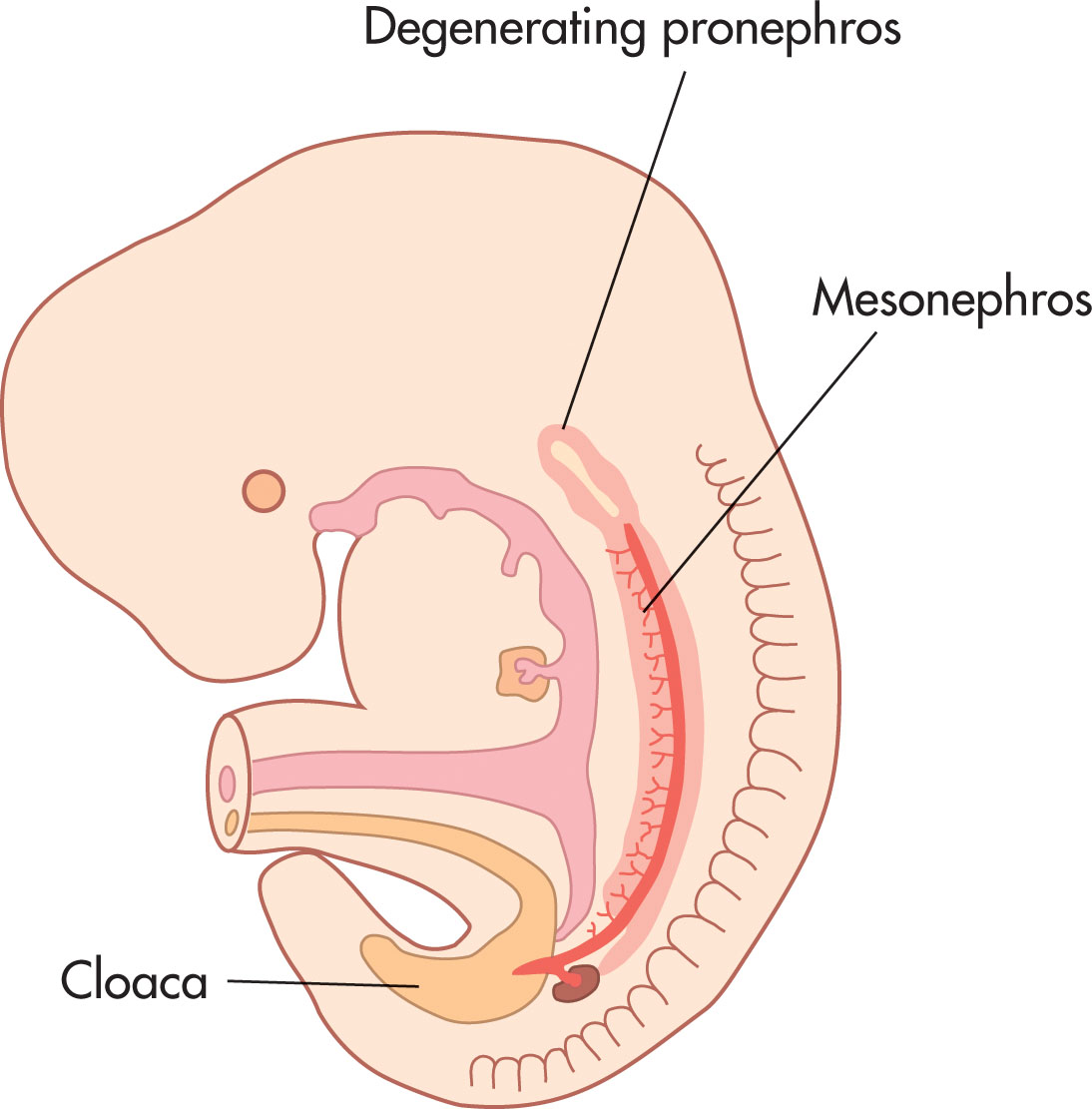
The permanent kidneys (metanephros) begin to develop early in the fifth week while the mesonephroi are still developing ( Fig. 64.2 ). Urine formation begins toward the end of the first trimester, around the 11th to 12th gestational week, and continues actively throughout fetal life. Urine is excreted into the amniotic cavity and forms a major part of the amniotic fluid. The kidneys do not need to function in utero because the placenta eliminates waste from the fetal blood. The kidneys must be able to assume their waste excretion role after birth.
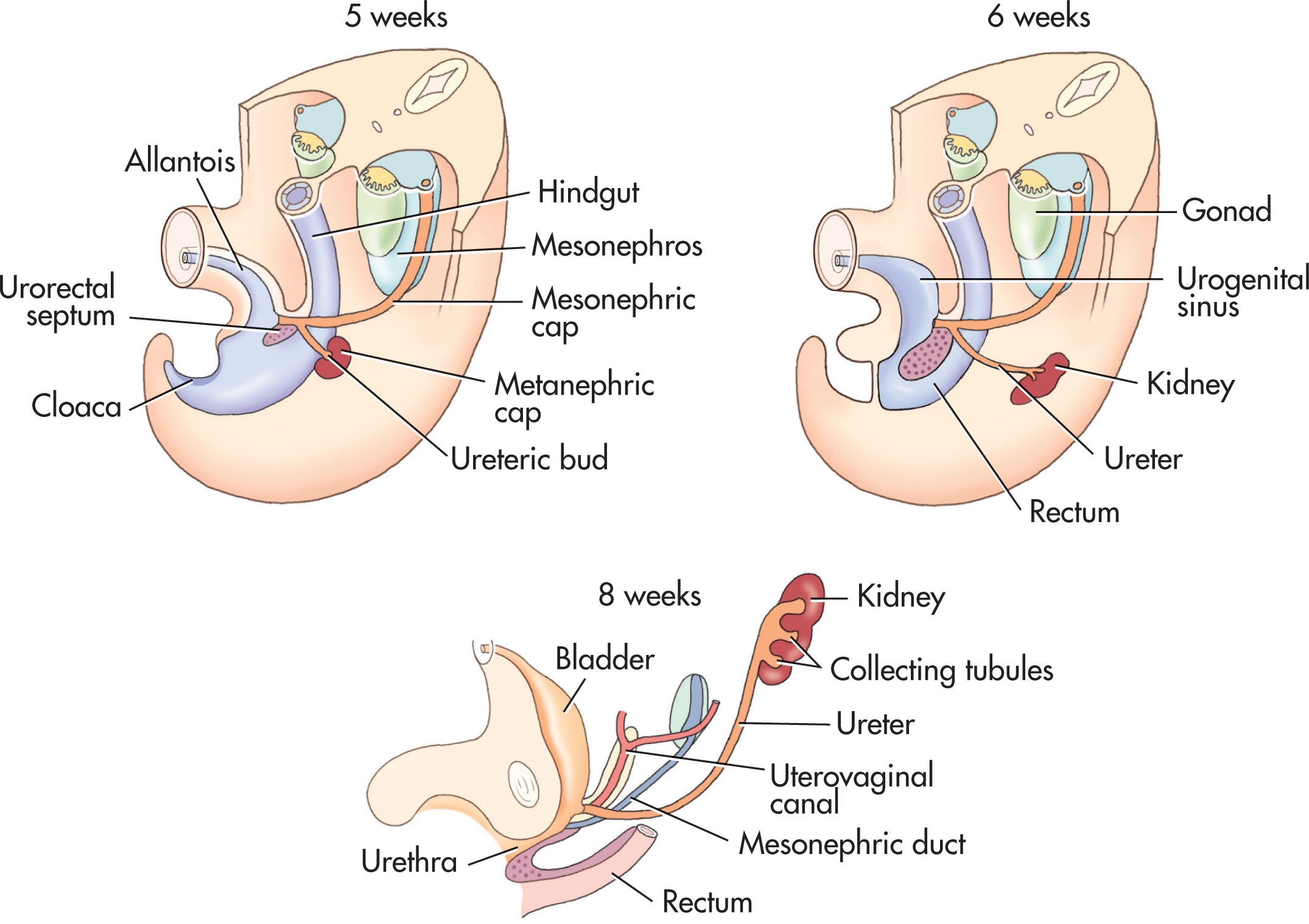
The permanent kidneys develop from two different sources: (1) the metanephric diverticulum or ureteric bud and (2) the metanephric mesoderm ( Fig. 64.3 ). The ureteric bud gives rise to the ureter, renal pelvis, calyces, and collecting tubules. The collecting tubule is also derived from the ureteric bud. The major and minor calyces are developed from these collecting tubules.

The ends of the tubules form metanephric vesicles. The ends of these tubules are invaginated by an ingrowth of the fine blood vessels, the glomerulus, to form a double-layered cup called the glomerular capsule or Bowman capsule. The renal corpuscle (glomerulus and capsule) and its associated tubules form a nephron. Each distal convoluted tubule contacts an arched collecting tubule, and then the tubules become confluent, forming a uriniferous tubule. Each uriniferous tubule consists of two parts: a nephron and a collecting tubule.
The arterial vascular supply to the kidneys comes from the arteries that arise from the aorta. Usually, these vessels disappear when the kidneys ascend, but some of them may persist, which accounts for the variations that can be found in the renal arteries. At least 25% of adult kidneys have two to four renal arteries.
The kidneys initially lie close together in the pelvis. Gradually, the kidneys migrate into the abdomen and become separated from one another ( Fig. 64.4 ). They normally complete this migration by the ninth week of gestation. In some cases, one of the kidneys may remain in the pelvic cavity while the other migrates into the posterior flank of the abdomen. With sonography, the identification of a pelvic kidney may be seen with adequate bladder dilation and may appear in females as a pelvic mass.
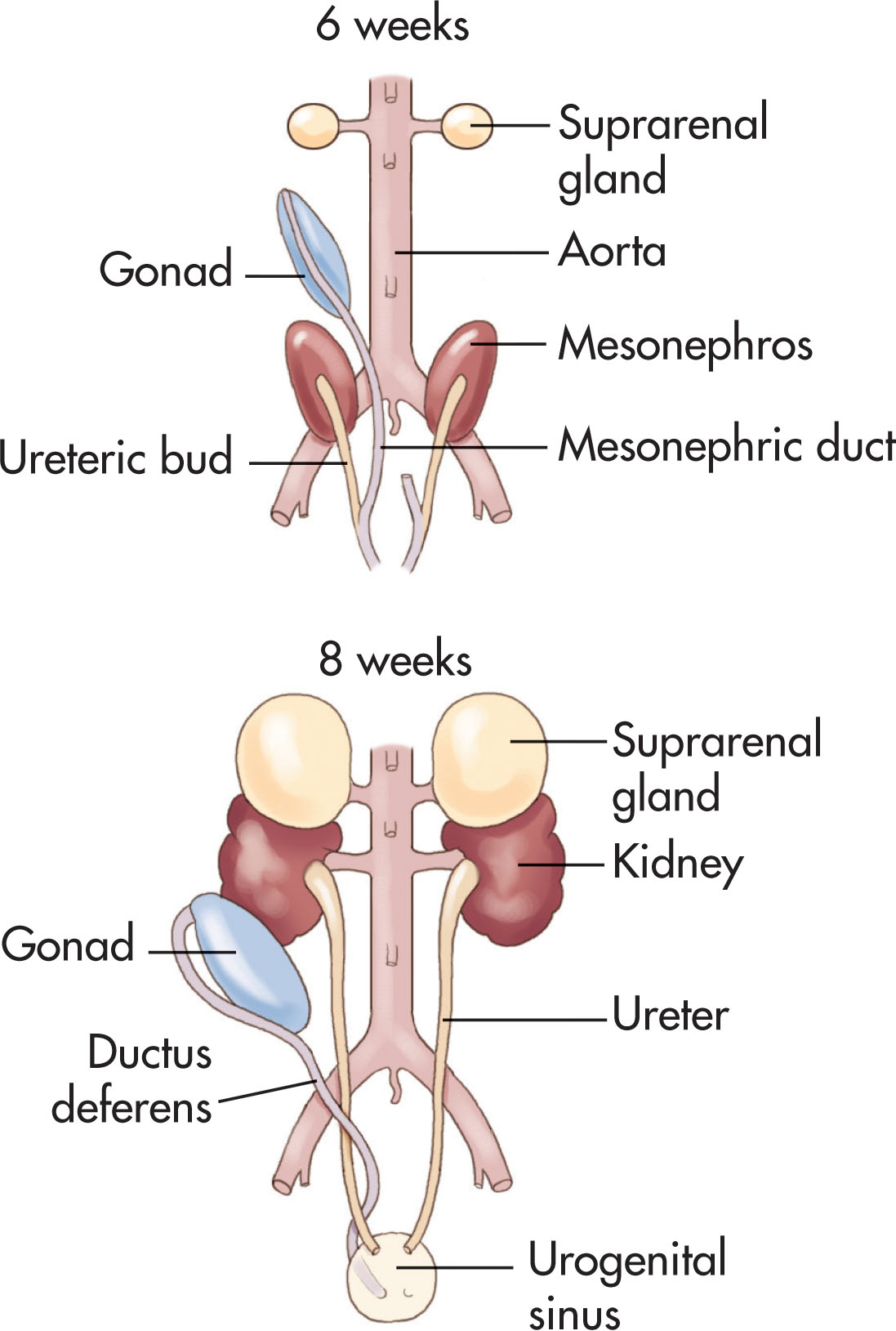
The fetal urinary bladder is derived from the hindgut derivative known as the urogenital sinus (see Fig. 64.2 ). The caudal ends of the mesonephric ducts open into the cloaca, and parts of them are gradually absorbed into the wall of the urinary bladder. This development causes the ureters (derived from the ureteric buds) and the mesonephric ducts to enter the bladder separately.
Although the kidneys migrate upward, the orifices of the ureters move cranially, and the primordia of the ejaculatory ducts (derived from the mesonephric ducts) move toward one another and enter the prostatic part of the urethra. The epithelium of the female urethra and most of the epithelium of the male urethra is derived from the endoderm of the urogenital sinus.
Although the early development of the external genitalia is similar for both sexes, distinguishing sexual characteristics begin during the ninth week and external genital organs are fully differentiated by the 12th week of gestation ( Fig. 64.5 ). In the fourth week, a genital tubercle develops at the cranial end of the cloacal membrane. Labioscrotal swellings and urogenital folds develop on either side of this membrane. The genital tubercle elongates to form a phallus, which is similar in both sexes. The hormonal changes cause further development of the male and female reproductive system ( Fig. 64.6 ).
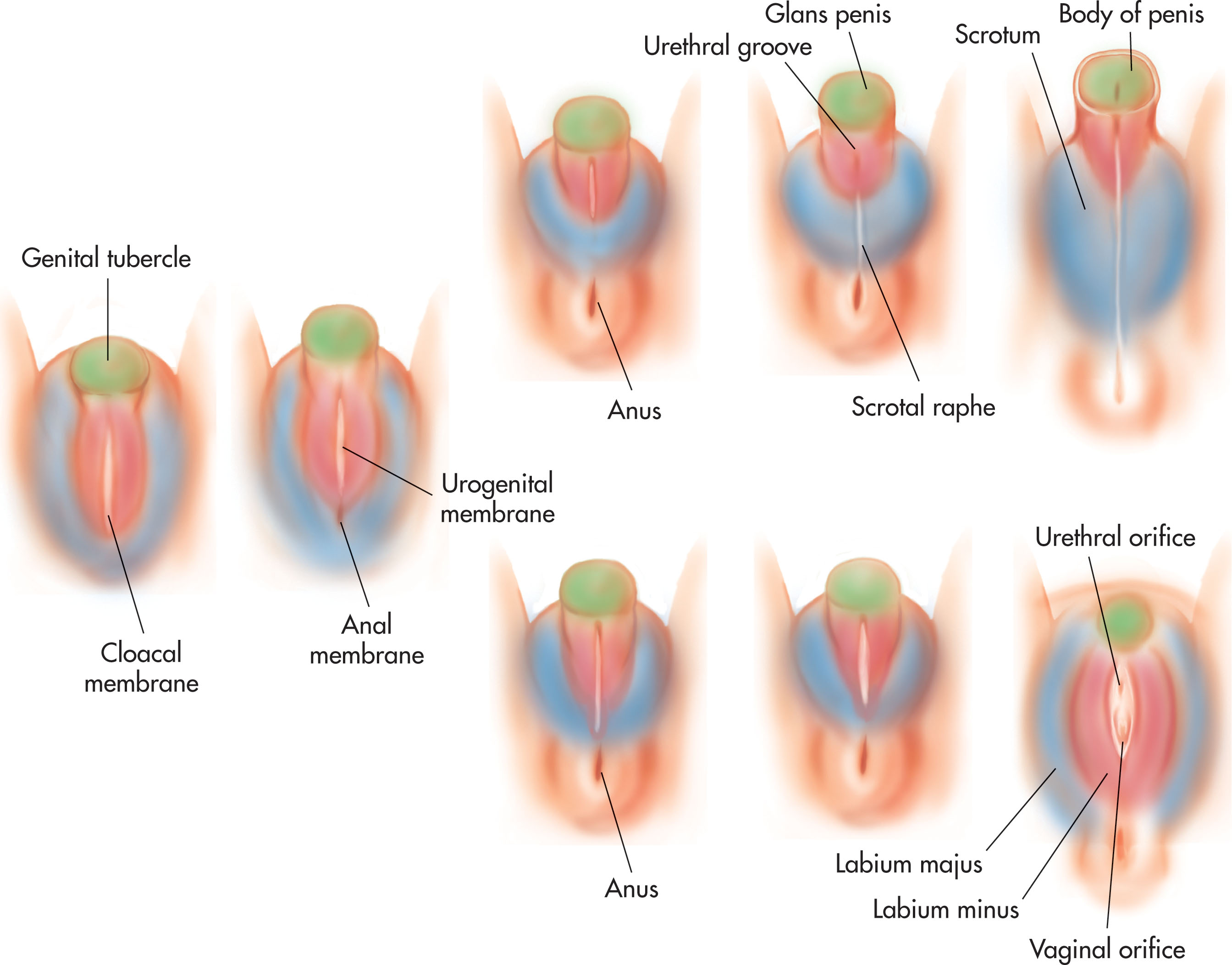
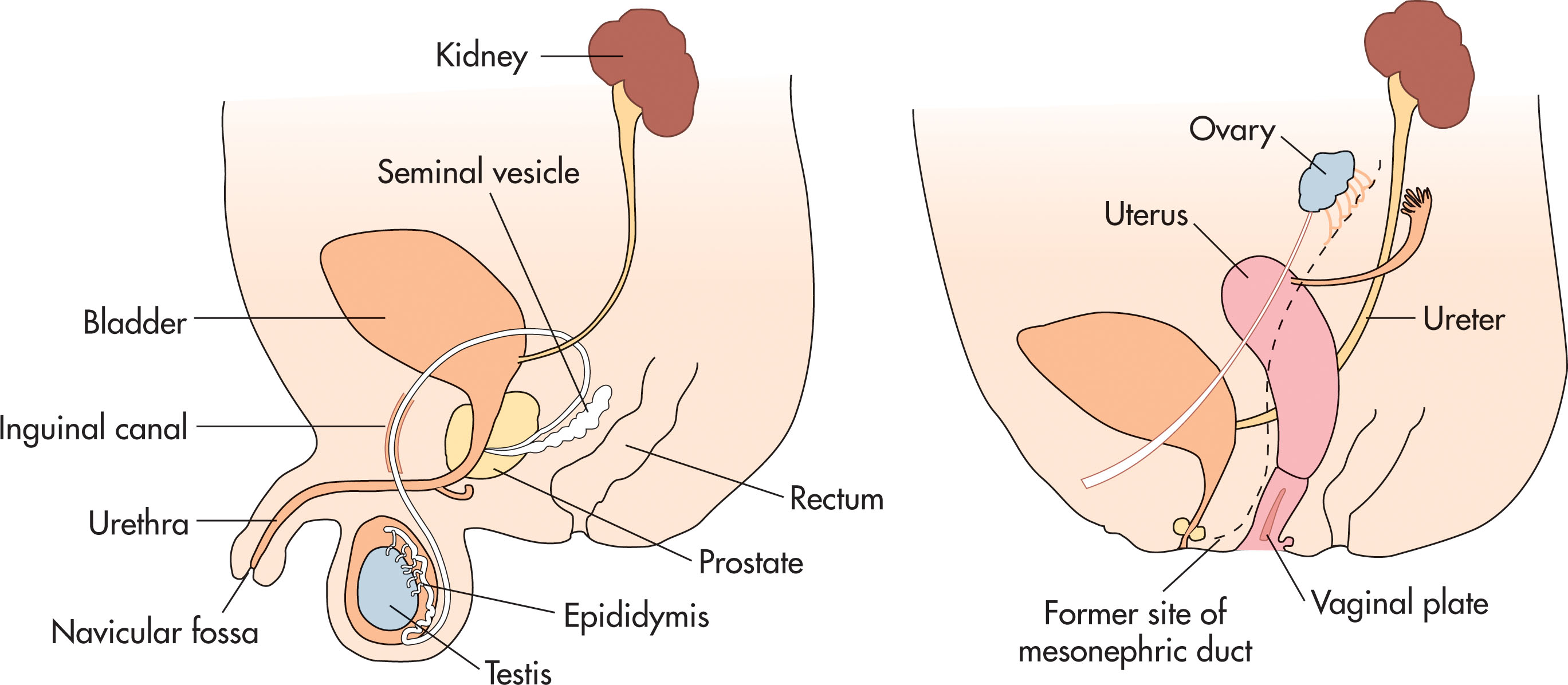
The fetal testes produce androgens that cause the masculinization of the external genitalia. The phallus elongates to form the penis. This sonographic finding is known as the “turtle” sign. The urogenital folds fuse on the ventral surface of the penis to form the spongy urethra. The labioscrotal swellings grow toward the median plane and fuse to form the scrotum. The line of fusion of the labioscrotal folds is called the scrotal raphe.
Both the urethra and vagina open into the urogenital sinus, the vestibule of the vagina. The urogenital folds become the labia minora, the labioscrotal swellings become the labia majora, and the phallus becomes the clitoris.
The kidneys should be evaluated by assessing their anatomy, texture, and size. With transvaginal sonography, the fetal kidneys have been documented as early as 9 weeks of gestation. By 12 weeks of gestation, at least 86% of the fetal kidneys may be imaged. The fetal kidneys and bladder may be seen sonographically by 13 weeks of gestation. The kidneys appear as bilateral hyperechoic structures in the paravertebral regions. At approximately 15 weeks of gestation, the overall echogenicity will decrease, and the renal pelvis may appear as sonolucent areas within the central kidney. As the fetal age advances, fat deposits in the perinephric and sinus regions become visible. Beginning at 18 weeks of gestation, kidneys should be documented in all fetuses sonographically. Between 18 and 20 weeks of gestation, the kidneys are slightly hyperechoic compared to surrounding tissues (i.e., bowel and paravertebral tissues). By 25 weeks of gestation, the renal cortex can be distinguished from the medulla, the renal capsule is clearly outlined, and a central echogenic area is seen in the renal sinus region ( Box 64.1 ). Sonographically, this would appear as a relatively homogeneous renal cortex and parenchyma, hypoechoic pyramids and calyces, and anechoic renal pelvis ( Fig. 64.7 ).
Bladder: assess presence and size
Kidneys: assess presence, number, position, and appearance (texture)
Collecting system: assess if normal or dilated; if dilated, look for level and cause of obstruction, whether it is unilateral or bilateral
Fetal sex
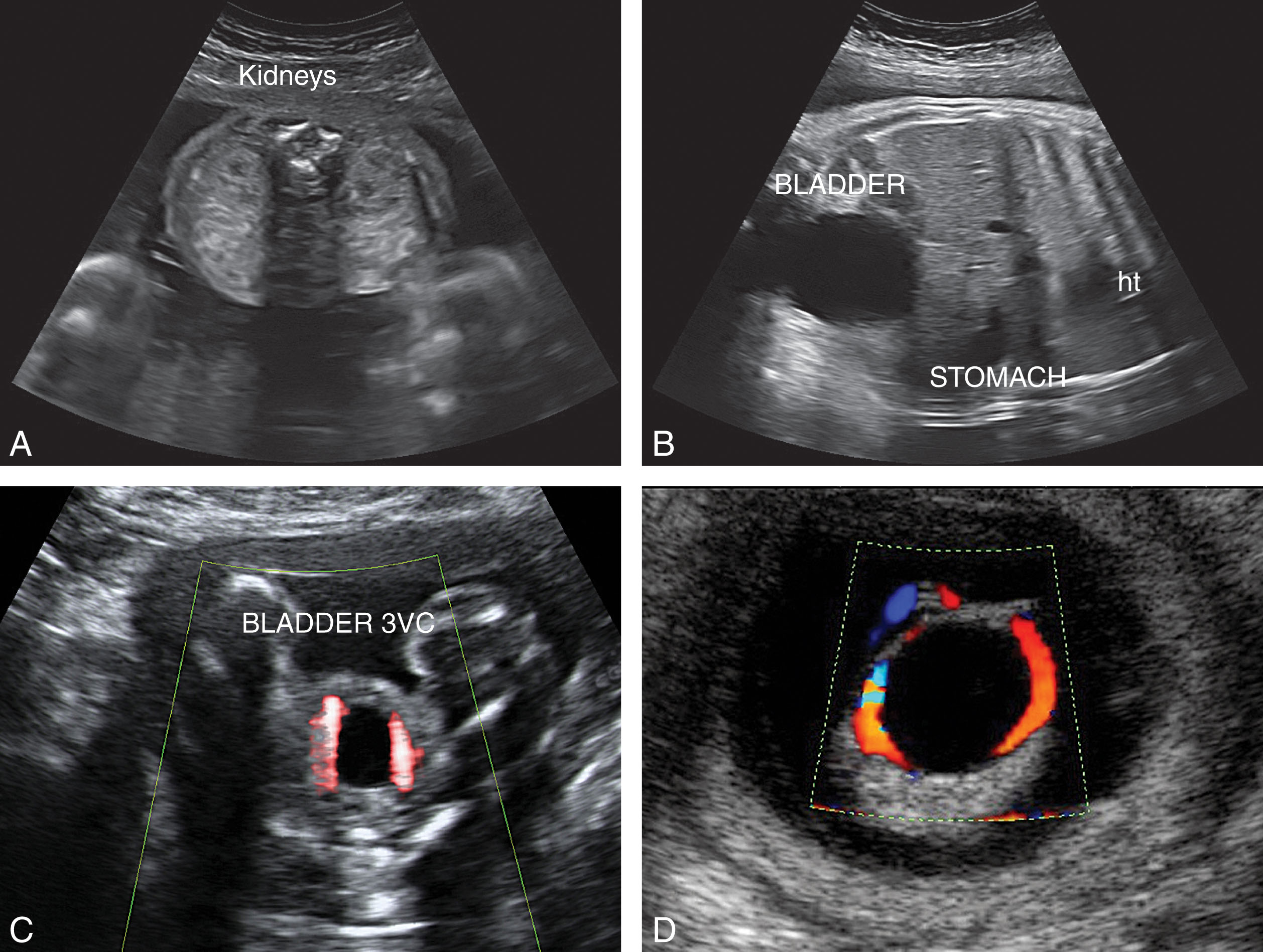
The kidneys can be imaged in the sagittal, transverse, or coronal planes. The size of the fetal kidneys may be assessed by measuring the length, width, and height (anterior-posterior [AP] diameter) of the kidney ( Table 64.2 ). In both the sagittal and transverse view, the kidneys can be best visualized with the fetal spine situated anteriorly on the screen. In the sagittal plane, kidney length and AP measurements can be obtained ( Fig. 64.8 ). This involves measuring the length of the kidney from the upper to lower pole. Careful attention should be made not to include the adrenal gland. The length of the kidney closely correlates with the gestational age of the fetus. The transverse view allows the sonographer to view both kidneys simultaneously. The kidneys are circular structures lying on each side of the spine. In this view, both kidneys can be evaluated and compared for echogenicity, width size, and renal pelvis size. The renal pelvis, if visible, may be measured in the AP diameter when the fetal spine is toward the maternal anterior wall ( Fig. 64.9 ). The upper limit of normal is 4 mm up to the third trimester and 7 mm from the third trimester until term. A small amount of urine may be seen in the renal pelvis in the normal fetus. On coronal images, the kidneys are bordered medially by the psoas muscles and superiorly by the hypoechoic adrenal glands.
| Age (Weeks) | Kidney Thickness (mm) | Kidney Width (mm) | Kidney Length (mm) | Kidney Volume (cm 3 ) | ||||||||
|---|---|---|---|---|---|---|---|---|---|---|---|---|
| 5th | 50th | 95th | 5th | 50th | 95th | 5th | 50th | 95th | 5th | 50th | 95th | |
| 16 | 2 | 6 | 10 | 6 | 10 | 13 | 7 | 13 | 18 | — | 0.4 | 2.6 |
| 17 | 3 | 7 | 11 | 6 | 10 | 14 | 10 | 15 | 20 | — | 0.6 | 2.8 |
| 18 | 4 | 8 | 12 | 6 | 10 | 14 | 12 | 17 | 22 | — | 0.7 | 2.9 |
| 19 | 5 | 9 | 13 | 7 | 10 | 14 | 14 | 19 | 24 | — | 0.9 | 3.1 |
| 20 | 6 | 10 | 13 | 7 | 11 | 15 | 15 | 21 | 26 | — | 1.1 | 3.3 |
| 21 | 6 | 10 | 14 | 8 | 12 | 15 | 17 | 22 | 28 | — | 1.4 | 3.6 |
| 22 | 7 | 11 | 15 | 8 | 12 | 16 | 19 | 24 | 29 | — | 1.7 | 3.9 |
| 23 | 8 | 12 | 16 | 9 | 13 | 17 | 21 | 26 | 31 | — | 2.1 | 4.3 |
| 24 | 9 | 13 | 17 | 10 | 14 | 18 | 22 | 28 | 33 | 0.3 | 2.5 | 4.7 |
| 25 | 10 | 14 | 18 | 11 | 15 | 19 | 24 | 29 | 34 | 0.8 | 3.0 | 5.2 |
| 26 | 11 | 15 | 19 | 12 | 16 | 19 | 25 | 31 | 36 | 1.3 | 3.5 | 5.7 |
| 27 | 11 | 15 | 19 | 12 | 16 | 20 | 27 | 32 | 37 | 1.9 | 4.1 | 6.3 |
| 28 | 12 | 16 | 20 | 13 | 17 | 21 | 28 | 33 | 38 | 2.5 | 4.7 | 6.9 |
| 29 | 13 | 17 | 21 | 14 | 18 | 22 | 29 | 35 | 40 | 3.2 | 5.4 | 7.6 |
| 30 | 14 | 18 | 22 | 15 | 19 | 23 | 31 | 36 | 41 | 3.9 | 6.1 | 8.3 |
| 31 | 14 | 18 | 22 | 16 | 20 | 24 | 32 | 37 | 42 | 4.6 | 6.8 | 9.0 |
| 32 | 15 | 19 | 23 | 17 | 20 | 24 | 33 | 38 | 43 | 5.4 | 7.5 | 9.7 |
| 33 | 16 | 20 | 23 | 17 | 21 | 25 | 34 | 39 | 44 | 6.1 | 8.3 | 10.5 |
| 34 | 16 | 20 | 24 | 18 | 22 | 26 | 35 | 40 | 45 | 6.8 | 9.0 | 11.2 |
| 35 | 17 | 21 | 25 | 18 | 22 | 26 | 35 | 41 | 46 | 7.4 | 9.6 | 11.8 |
| 36 | 17 | 21 | 25 | 19 | 23 | 27 | 36 | 41 | 47 | 8.1 | 10.2 | 12.4 |
| 37 | 18 | 22 | 26 | 19 | 23 | 27 | 37 | 42 | 47 | 8.6 | 10.8 | 13.0 |
| 38 | 18 | 22 | 26 | 19 | 23 | 27 | 37 | 43 | 48 | 9.0 | 11.2 | 13.4 |
| 39 | 19 | 23 | 27 | 19 | 23 | 27 | 38 | 43 | 48 | 9.4 | 11.6 | 13.8 |
| 40 | 19 | 23 | 27 | 19 | 23 | 27 | 38 | 44 | 49 | 9.6 | 11.8 | 14.0 |
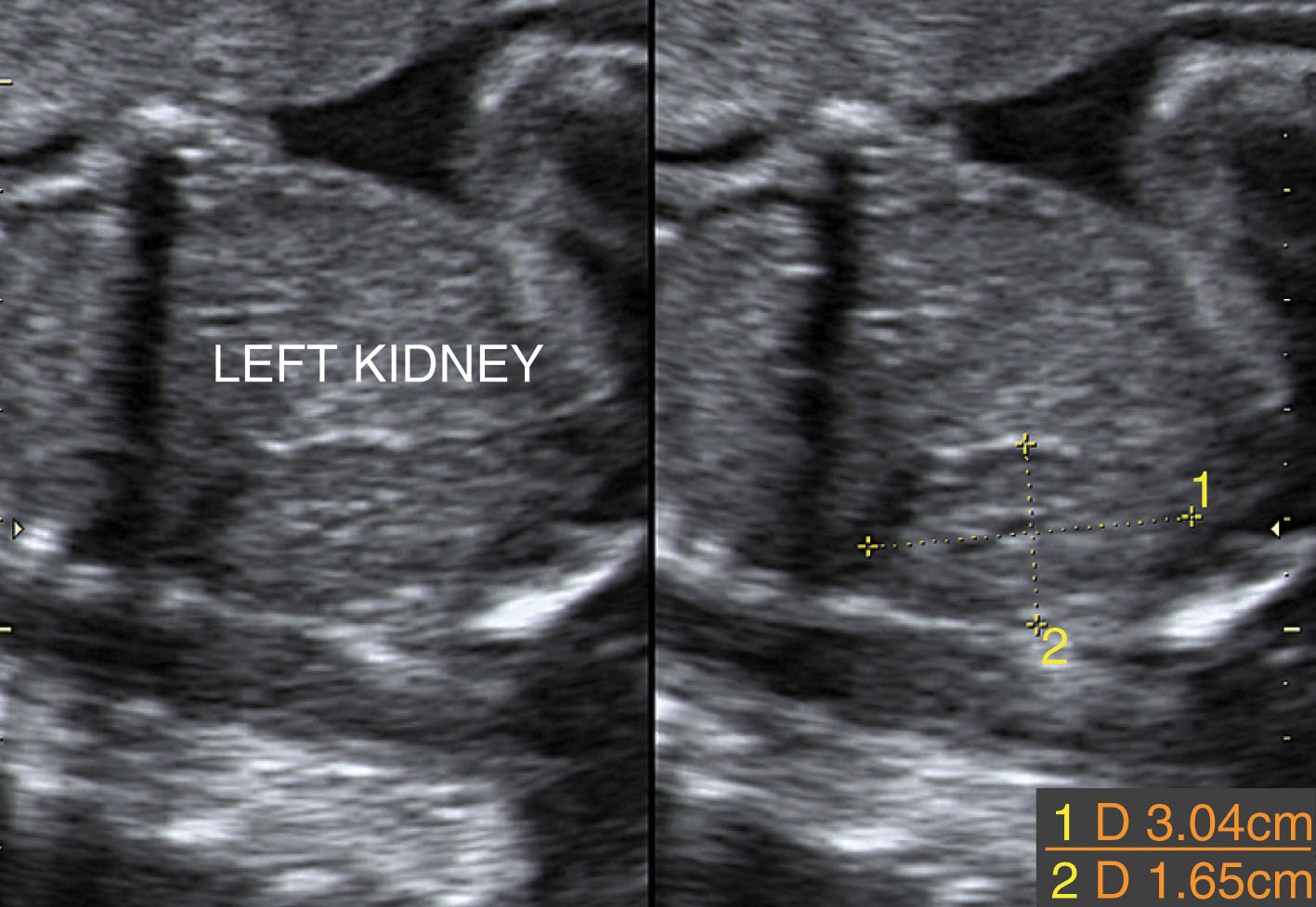
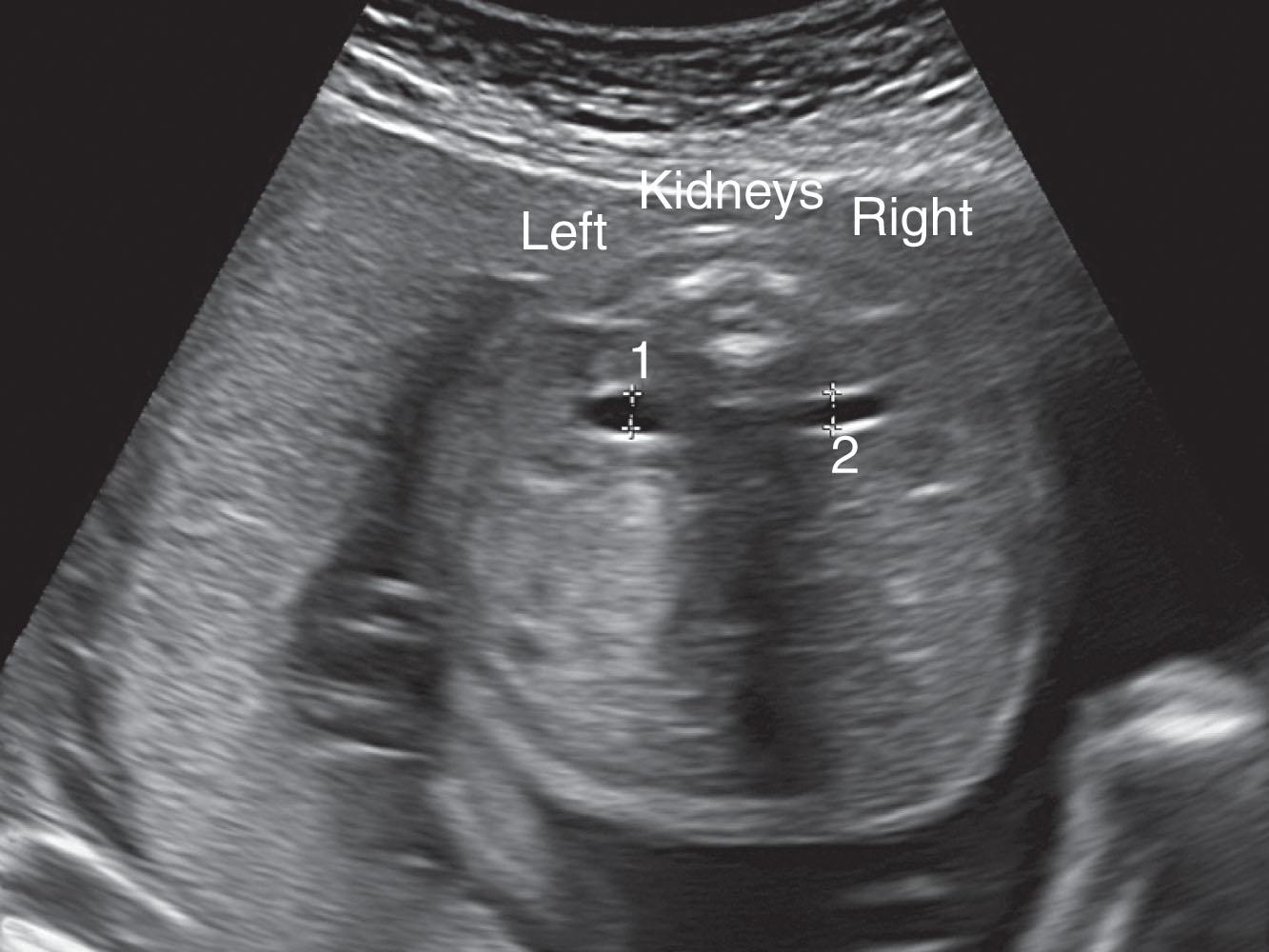
In normal conditions, the fetal bladder is well visualized as an anechoic structure in the fetal pelvis (see Box 64.1 ). The fetal ureters and urethra are typically not seen. The ureter visualized sonographically as an anechoic fluid structure at the renal pelvis in normal conditions with the ureters measuring less than 1 mm to 2 mm in diameter. Urine jets may be seen in the bladder where the ureters enter.
The bladder is imaged as a rounded echo-free area located centrally in the pelvis (see Fig. 64.7B–D ). There is no specific bladder measurement usually applied; however, documentation of the bladder filling and emptying is important. Sonographers should identify the fetal bladder early in the ultrasound examination to make sure adequate fluid is present. If no bladder is seen or the bladder appears too large, the sonographer should reevaluate the bladder at the end of the examination. This is due in part to the fact that the fetal bladder usually takes at least 30 minutes to fill and empty. The normal bladder wall can be measured and should be thin in a normal fetus. Normal measurement of the wall is 2 mm or less and is best measured at the level of the umbilical artery.
Determination of the fetal sex should be documented with the presence of other abnormalities or in cases in which the external organ does not meet the sonographic criteria for a male or female. Therefore, it is extremely important that the sonographer use specific sonographic criteria when determining the sex of the fetus. The inability to visualize the penis and scrotum should not be used as the determining factor to identify a female fetus.
In the majority of fetuses, the external genitalia can be differentiated in the second trimester. In the first trimester, differentiation is hard to determine due to the protrusion of the external genital tubercle. The genital tubercle will appear the same in the male and female fetus. In the second trimester, identification of the female fetus should only be determined when the major and minor labia are seen. Visualization of the labia is often called the “hamburger” sign ( Fig. 64.10A ). The male fetus in second trimester is determined by the visualization of the penis and scrotal sac, also known as the “turtle” sign (see Fig. 64.10C ). The testes are not visible within the scrotal sac until approximately 28 weeks of gestation. The use of three-dimensional (3D) or four-dimensional (4D) imaging has proven helpful as well (see Fig. 64.10B and D ).

Amniotic fluid is a critical marker in the assessment of renal function. The fetal kidneys begin to excrete urine after the 11th week but do not become the major contributor of fetal urine (and hence of amniotic fluid volume) until 14 to 16 weeks of pregnancy. Therefore, the observation of normal amniotic fluid volume before this time will not exclude the possibility of renal agenesis (absent kidneys).
In this section, several sonographic findings are listed that suggest abnormalities of the urogenital system. Detail descriptions of each pathology mentioned will follow on later pages. This section is intended to stimulate the sonographer’s mind into thinking through any abnormality that may be seen and documenting images specifically related to the abnormality. Sonographers should be encouraged to critically think through their images and document supporting evidence that would aid in diagnosis.
Obstructions of the urinary system may originate anywhere along the urinary tract. The sonographic features of the dilation include anechoic enlargement of the affected area ( Fig. 64.11A ). The consequences and sonographic findings of an obstruction depend on the origin of the blockage. For example, in fetuses with a urethral obstruction, such as complete posterior urethral valve obstruction, urine is unable to pass through the urethra and into the amniotic fluid. Consequently, urine backs up in the posterior urethra, bladder, and ureters and often extends to the kidneys (hydronephrosis).
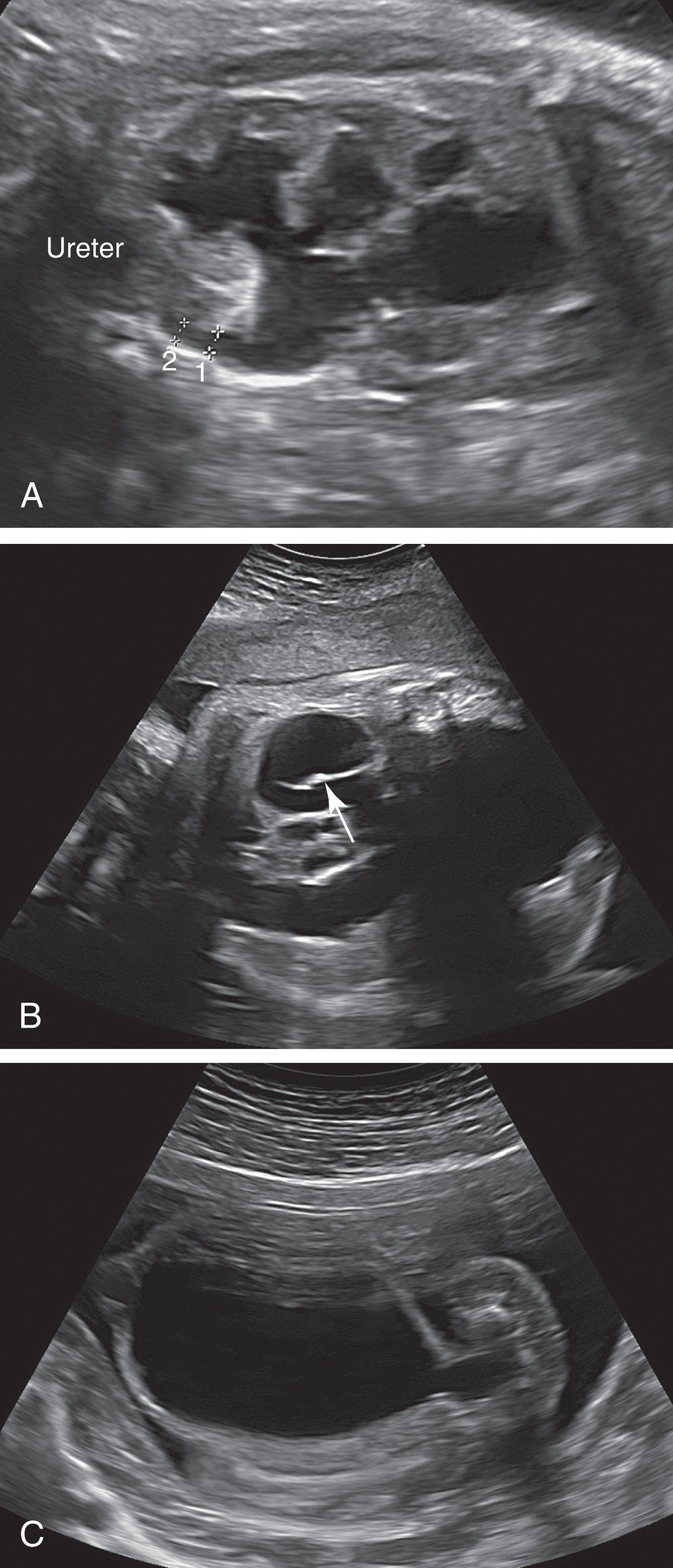
If dilation of the renal collecting system is present, either hydronephrosis or reflux should be considered. Complete sonographic evaluation of the kidney, ureter, and bladder should be made to help determine the level of the obstruction causing the dilation. The level of obstruction is determined by the degree of dilation of the renal pelvis and ureter. When the entire renal collecting system is involved, a simple hydronephrosis is usually the cause. Ureteropelvic junction obstruction shows dilation of the renal pelvis, whereas ureteric dilation suggests either a ureterovesical junction obstruction or reflux (see Fig. 64.11B ). Ureterovesical reflux may also cause bilateral hydronephrosis. When the hydronephrosis is bilateral, the possibility of bladder outlet obstruction should be considered. The sonographer should look for dilated ureters, thickened (hypertrophied) bladder wall, and dilation of the posterior urethra (see Fig. 64.11C ). The renal parenchyma should be made in the presence of hydronephrosis. If an echogenic cortex is present with subcapsular cysts, secondary renal dysplasia and poor function of the affected kidney may be present. In cases of urethral obstruction and bilateral renal dysplasia, oligohydramnios is typically noted after 16 weeks of gestation.
Duplication of the renal collecting system is common. It usually occurs in females and typically is not diagnosed in utero. The duplication occurs during embryology in which two ureteral buds are formed. The term moiety is often used to describe the two parts of the kidney. The degree of duplication will vary: two renal pelves are noted with two ureters each entering the bladder, two renal pelves join to form one ureter, and two renal pelves with two ureters that join in the abdominopelvic cavity before bladder insertion.
In most cases, the upper pole is susceptible to obstruction whereas the lower pole is susceptible to reflux. In utero, the sonogram may reveal an enlarged kidney; however, the presence of hydronephrosis located high in the kidney rather than mid is an indication of possible obstruction related to duplication. The bladder should be carefully examined for the presence of a ureterocele . Ureteroceles are commonly associated with duplicated collecting systems and appear as an anechoic cystic structure within the bladder.
The cause and sonographic appearance of fetal renal cysts vary. Careful assessment of the kidneys includes comparison of both kidneys as well as distinguishing cyst from hydronephrosis. For example, a multicystic kidney may be seen with a large central cyst and multiple small noncommunicating peripheral cysts. Hydronephrosis involving the calyces can be differentiated from the multicystic kidney by verifying communication among the cysts. A single large cyst most likely represents a simple renal cyst.
When the kidneys appear enlarged and echogenic, the sonographer should consider a form of polycystic disease, trisomy 13, or Meckel-Gruber syndrome. In cases of congenital polycystic diseases, a thorough review of family history should be completed. In infantile polycystic renal disease, oligohydramnios may be present, whereas normal amniotic fluid volumes are seen with adult polycystic disease. In cases of syndrome association, a complete obstetric sonogram will most likely reveal other findings related to the syndrome.
Kidneys should be visualized at the same level on each side of the spine in the transverse view. If either kidney is not visualized, the sonographer should evaluate for a pelvic kidney or absence of one or both kidneys. A pelvic kidney may be visualized with a thorough evaluation of the fetal pelvis. Renal agenesis may involve one or both kidneys. In unilateral renal agenesis the contralateral kidney is usually quite large because of compensating for the absent kidney. If both kidneys are absent, the bladder will not be seen, the stomach will not be seen, and severe oligohydramnios is evident beginning in the second trimester. Early in the first trimester, the oligohydramnios may not be apparent, and the stomach may be visible. The use of color Doppler aids in determining the location of the renal vessels leading into the kidney or lack of kidney.
Failure to observe the bladder may indicate a severe renal abnormality when accompanied by oligohydramnios. When obstruction occurs at the level of the urethra, the bladder wall becomes hypertrophied. The presence of ureteral jets may be assessed in the fetus to rule out obstruction. Using color Doppler over the area of the bladder, near the base, will aid in the visualization of ureteral jets. The presence of ureteral jets streaming into the bladder indicates that the ureter is not obstructed.
When the ureters are pathologically dilated, they become visible as tortuous cystic masses in the midportion of the lower fetal pelvis. Abnormally dilated ureters are referred to as hydroureters and may be traced into the kidney and bladder (see Fig. 64.11B ). Careful attention should be made not to mistake the dilated ureter for bowel. In cases of unilateral ureter obstruction, the amniotic fluid will most likely be low to normal; however, if both ureters are obstructed, oligohydramnios will be present.
Dilation of the posterior urethra is highly suspicious for an obstructive process, such as posterior urethral valve syndrome, known as the key bladder sign on sonography, as the dilated bladder has the shape of a keyhole superior to the obstructed urethra (see Fig. 64.11C ). Both kidneys will appear with severe hydronephrosis (late stages may appear with dysplastic changes), oligohydramnios will be present, the stomach will not be seen, and both ureters will be dilated. The posterior urethral valve occurs only in male fetuses and is manifested by the presence of a valve in the posterior urethra.
Amniotic fluid volume is a significant factor in predicting outcome. Box 64.2 lists common renal abnormalities. In fetuses with severe renal disease, amniotic fluid is reduced, and in the most severe malformations, it is virtually absent. When severe oligohydramnios is found, usually both kidneys or ureters and the urethra are malformed. Unilateral obstructions may yield a normal amount of amniotic fluid because the contralateral kidney produces urine. Conversely, hydramnios may be present with some renal disorders, such as mesoblastic nephroma and unilateral renal obstruction.
Renal agenesis
Multicystic renal dysplasia
Congenital hydronephrosis
Renal duplication
Pelvic kidney
Horseshoe kidney
Infantile polycystic kidney disease
Adult polycystic kidney disease
Meckel-Gruber syndrome
Renal malformations may be divided into two categories: (1) those involving congenital malformation and (2) those resulting from an obstructive process (see Box 64.2 ). The consequences of renal malformations vary depending on the type of lesion and extent of obstruction ( Fig. 64.12 ). The recognition of urinary tract anomalies is of significant clinical concern because several fetal conditions are incompatible with life. Recognition of lethal or treatable renal anomalies is necessary to ensure appropriate clinical and therapeutic management.
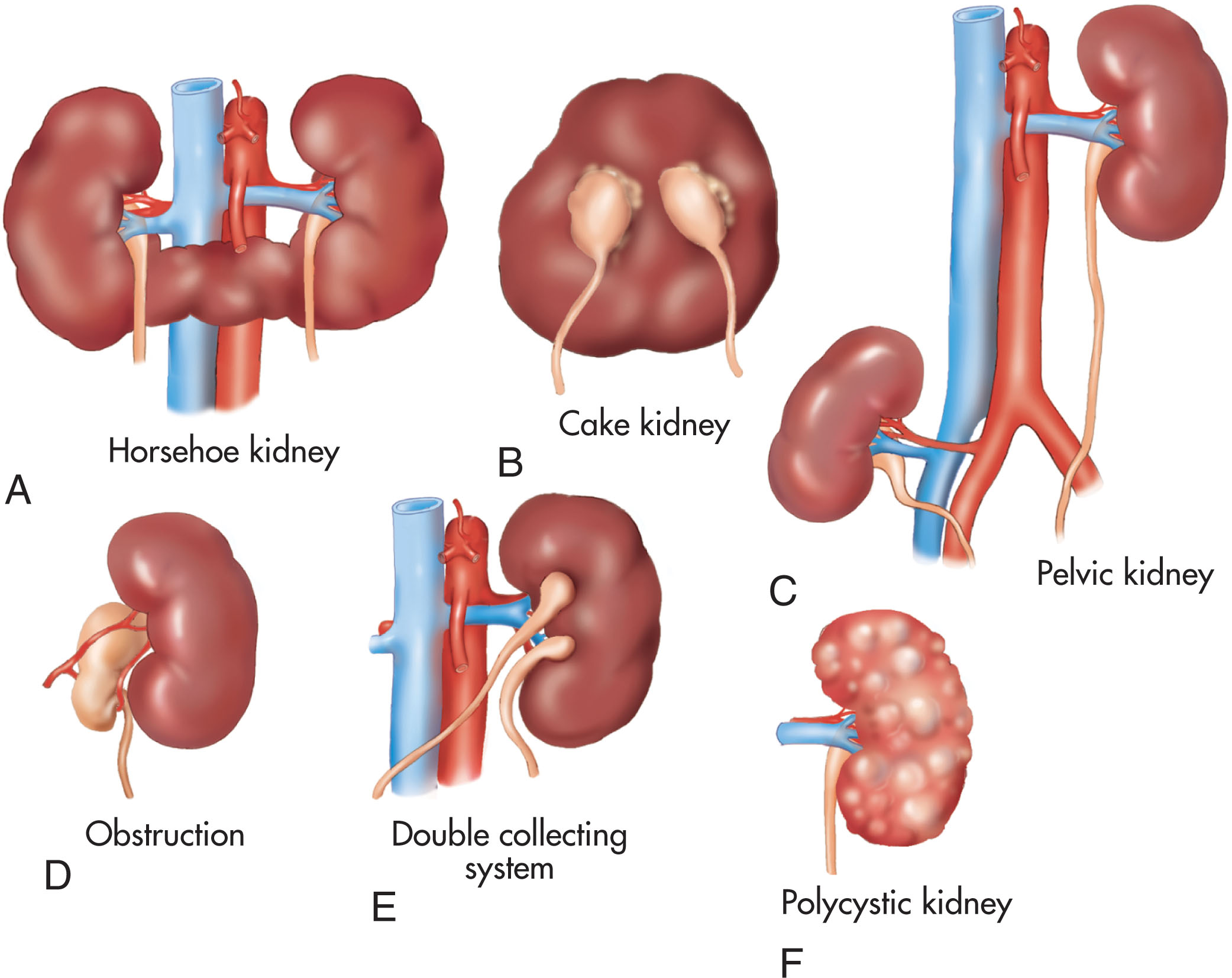
Complete absence of the kidney(s) is known as renal agenesis. This condition occurs when the ureteric buds fail to develop or when they degenerate before they can induce the metanephric mesoderm to form nephrons.
Prognosis is dependent on unilateral or bilateral involvement of the kidneys as well as associated abnormalities. In the diagnosis of renal agenesis, acquiring a complete clinical history and a thorough examination of all fetal structures is critical. Family members should be screened for renal abnormalities to rule out the possibility of autosomal dominant inheritance. Clinical history should include documentation of possible cocaine usage and maternal diabetes. Both have been linked to renal agenesis.
Bilateral renal agenesis is a lethal disorder due to renal insufficiency and hypoplasia of the lungs. The absence of amniotic fluid plays a role in the underdevelopment of the fetal lungs. In cases of unilateral agenesis, the presence of at least one functioning kidney contributes to excellent survival rates. Therefore, unilateral agenesis carries a good prognosis, especially with appropriate urologic follow-up. Bilateral agenesis occurs in 1 in 3000 to 1 in 10,000 births and the male-to-female ratio is 2.5:1. Unilateral agenesis is more common and has been estimated to occur in 1 in 600 to 1000 births with a male-to-female ratio of 1:1.
Bilateral renal agenesis is often referred to as Potter syndrome . Infants born with bilateral renal agenesis exhibit Potter facies (flat nose, recessed chin, abnormal ears, and wide-set eyes) and abnormal or malpositioned limbs. These deformities are caused by the lack of amniotic fluid. Under normal conditions amniotic fluid protects the fetus from the walls of the uterus allowing fetal structures such as the extremities to open and close. In cases of oligohydramnios, the uterine walls place pressure on the fetus and the fetal extremities are typically held in limited positions, leading to abnormal development.
Other fetal anomalies found in association with bilateral renal agenesis include cardiac defects and musculoskeletal disorders (sirenomelia, absent radius and fibula, anomalies of the digits, sacral agenesis, diaphragmatic hernia, and cleft palate). Central nervous system anomalies include hydrocephalus, meningocele, cephalocele, holoprosencephaly, anencephaly, and microcephaly. Gastrointestinal anomalies include duodenal atresia, imperforate anus, tracheoesophageal fistula, malrotation, and omphalocele. The sonographer should understand that most of these malformations are not detected prenatally because of poor visualization resulting from anhydramnios (complete lack of amniotic fluid). Unilateral agenesis may be associated with uterine anomalies in females and testicular hypoplasia, agenesis, or hypospadias in males. It should also be noted that there is a high incidence of abnormalities in the functioning kidney, specifically vesicoureteral reflux.
Sonographic findings are dependent on unilateral or bilateral renal agenesis. In both cases, the kidney or kidneys are not visualized ( Figs. 64.13 and 64.14 ). Careful examination of the abdominopelvic region must be completed to rule out a possible ectopic or pelvic kidney. Color Doppler can be used to delineate the renal vessels and the attachment to the aorta in the area of the kidneys. In the renal fossa of the absent kidney(s), the adrenal gland may mimic the kidney. The adrenal gland will appear hypoechoic with an echogenic center and in a flattened or lying-down position.

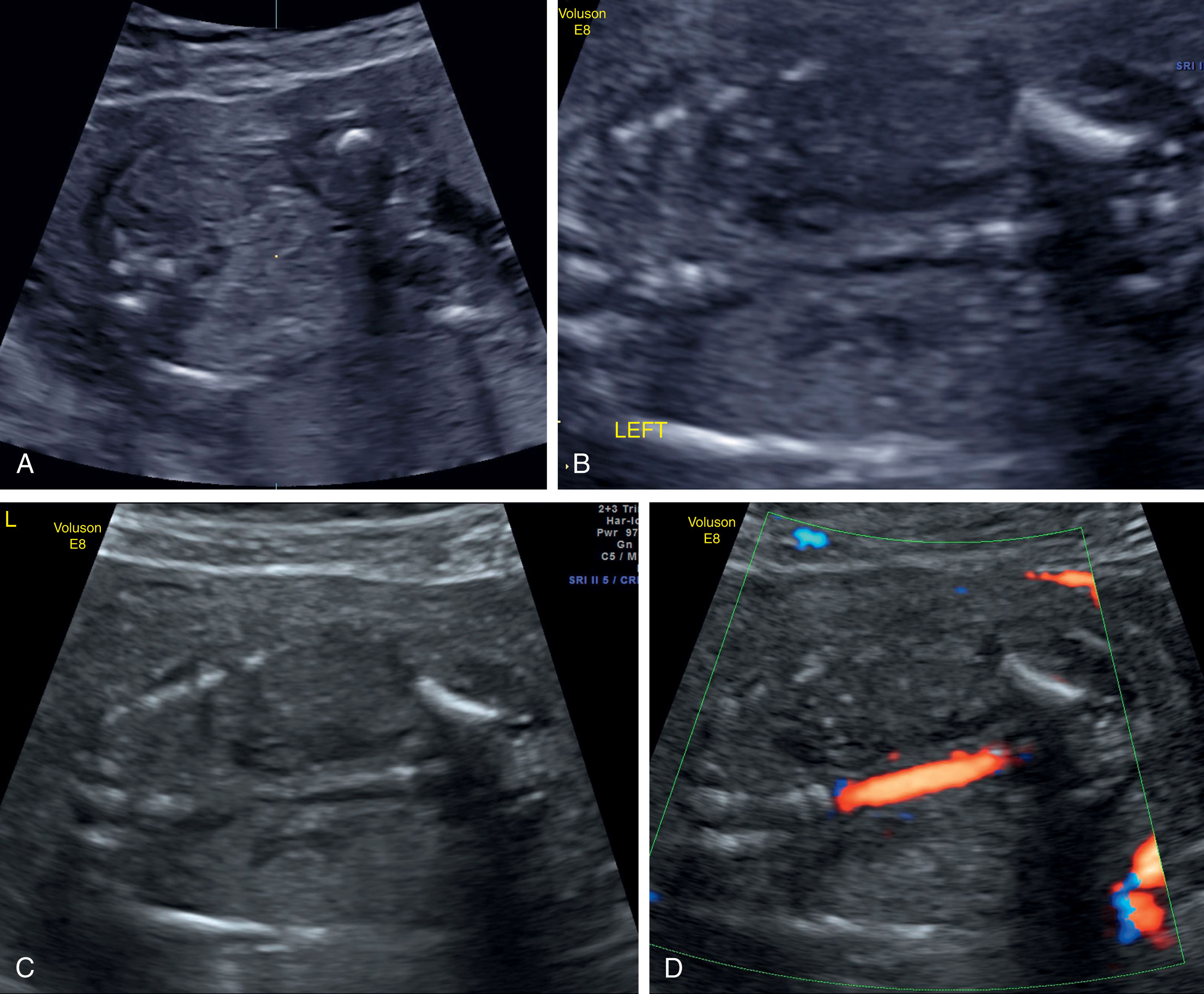
In bilateral renal agenesis, the kidney(s) and bladder are not visualized sonographically ( Box 64.3 ; see Fig. 64.14 ). Nonvisualization of the anechoic urinary bladder during 1 hour of consistent scanning has been considered a sonographic sign of bilateral renal agenesis. The lack of urine being produced results in oligohydramnios. In the early stages of renal agenesis (before 15 to 18 weeks), amniotic fluid may be visible as it is produced from other fetal sources.
Severe oligohydramnios after 13–15 weeks of menstrual age
Persistent absence of urine in fetal bladder (observe for period of 1 hour)
Failure to visualize kidneys or renal arteries (use color flow to outline renal arteries)
Abnormally small thorax
In unilateral renal agenesis, the contralateral kidney may be hypertrophied to compensate for the absent kidney (see Fig. 64.13B ). Therefore, the length of the kidney present will be greater than the gestational age. The bladder will be visualized, and adequate amounts of amniotic fluid are produced.
A horseshoe kidney forms when the inferior poles of the kidney fuse while they are in the pelvis. This fusion may occur in 1 to 4 in 1000 births and is 2 to 3 times more common in males (see Fig. 64.12 ).
Horseshoe kidneys may be found as an isolated anomaly or in associated with other anomalies or syndromes. The frequency of horseshoe kidneys is approximately 1 in 450 births. Isolated horseshoe kidneys carry a good prognosis. Renal conditions, such as kidney stones, urinary tract infections, hydronephrosis, and reflux, are often associated with horseshoe kidneys.
The presence of other abnormalities is uncommon. Central nervous system disorders, cardiac abnormalities, and/or urogenital abnormalities have been documented. The incidence of trisomy 18 and 45,X has also been noted. The presence of other abnormalities directly affects the outcome of the fetus.
The horseshoe kidney is the fusion of the lower poles of both kidneys. In general, horseshoe kidneys are difficult to diagnosis in utero. The bridge of tissue connecting the lower poles must be demonstrated for accurate diagnosis. In a transverse image of the fetal abdomen with the spine down, a connecting isthmus may be seen anterior to the aorta. In the sagittal and coronal views, clear delineation of the inferior pole of the kidney is not well seen and the kidneys may appear oblique.
As discussed, the kidneys initially lie remarkably close in the pelvis. Gradually they migrate into the abdomen and become separated from one another. They normally complete this migration by the ninth week of gestation. In some cases, one of the kidneys may remain in the pelvic cavity while the other migrates into the posterior flank of the abdomen.
Ectopic kidney(s) occurs when the kidney lies outside of its normal position in the renal fossa, usually in the area of the pelvis (see Fig. 64.12 ). Occasionally, crossed ectopia will occur. In crossed ectopia, both kidneys may be fused or appear to be fused because they are located on the same side of the body (considered a form of horseshoe kidney). The crossed-fused ectopic kidney lies on the opposite side of the abdomen relative to its ureteral insertion into the bladder. The kidneys are usually fused together and are usually found on the right side of the abdomen. In rare incidences, the kidney may be located in the thoracic cavity and more commonly on the left side.
Prognosis for ectopic kidneys is based on acquired complications or in association with other anomalies. Ectopic kidneys can have complications of dilation or dysplasia. Associated anomalies include skeletal, cardiovascular, gynecologic, and gastrointestinal abnormalities.
Sonography will demonstrate absence of the kidney in its normal position, with the adrenal gland filling the space of the renal fossa. The abnormally located kidney will typically be smaller and rotated obliquely or horizontal. If the kidney is located in the pelvis, it is typically found lying superior to the bladder or adjacent to the iliac wing ( Fig. 64.15 ). In cases of crossed-fused ectopic kidneys, both kidneys will appear on the same side demonstrating an enlarged bilobed kidney.
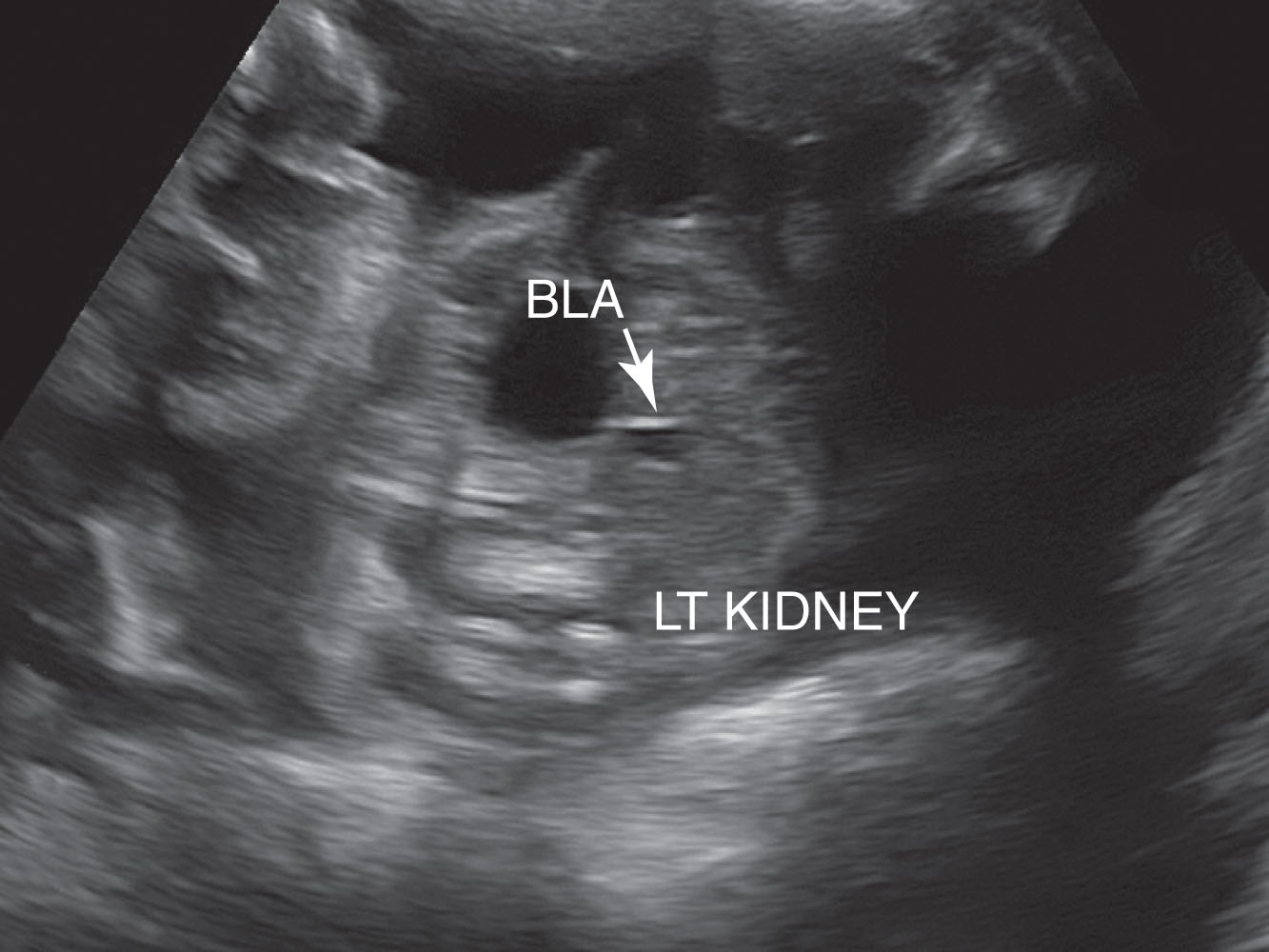
Exstrophy of the bladder is characterized by the protrusion of the posterior wall of the urinary bladder, which contains the trigone of the bladder and the ureteric orifices. It is caused by the defective closure of the inferior part of the anterior abdominal wall during the fourth week of gestation. As a result, no muscle or connective tissue forms in the anterior abdominal wall to cover the urinary bladder, resulting in the bladder forming external to the abdominal wall.
Exstrophy of the bladder occurs primarily in males, with an incidence of 1 in 30,000 births. It is most likely of sporadic occurrence and isolated. Laboratory markers will reveal an elevated maternal serum alpha-fetoprotein. Genitalia malformations are commonly seen, such as undescended testes or anterior displaced scrotum and a small penis with epispadias in males or a cleft clitoris in females. Multiple surgical procedures are required to correct the bladder abnormality as well as other associated genital anomalies. In the majority of cases urinary continence is restored.
Become a Clinical Tree membership for Full access and enjoy Unlimited articles
If you are a member. Log in here